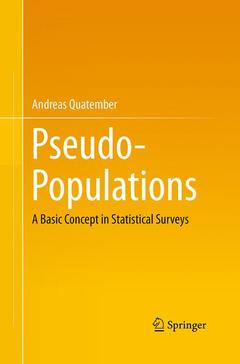Description
Pseudo-Populations, Softcover reprint of the original 1st ed. 2015
A Basic Concept in Statistical Surveys
Author: Quatember Andreas
Language: English
Subject for Pseudo-Populations:
Publication date: 08-2016
Support: Print on demand
Publication date: 10-2015
138 p. · 15.5x23.5 cm · Hardback
Description
/li>Contents
/li>Biography
/li>Comment
/li>
This book emphasizes that artificial or pseudo-populations play an important role in statistical surveys from finite universes in two manners: firstly, the concept of pseudo-populations may substantially improve users? understanding of various aspects in the sampling theory and survey methodology; an example of this scenario is the Horvitz-Thompson estimator. Secondly, statistical procedures exist in which pseudo-populations actually have to be generated. An example of such a scenario can be found in simulation studies in the field of survey sampling, where close-to-reality pseudo-populations are generated from known sample and population data to form the basis for the simulation process.
The chapters focus on estimation methods, sampling techniques, nonresponse, questioning designs and statistical disclosure control.
This book is a valuable reference in understanding the importance of the pseudo-population concept andapplying it in teaching and research.Statistical Surveys.- The Pseudo-Population Concept .- Nonresponse and Untruthful Answering.- Simulation Studies in Survey Sampling.- The Bootstrap Method in Survey Sampling.- Generalized Randomized Response Questioning Designs.- A Unified Framework for Statistical Disclosure Control.- References.- Subject Index.
Andreas Quatember is Associate Professor at the Department for Applied Statistics (IFAS) at the Johannes Kepler University JKU in Linz (Austria). He studied Statistics and wrote his doctoral thesis on "Quota Sampling". His main research topics are sampling theory and survey methodology. Currently, he is working on the project “Data quality in statistical surveys”.




